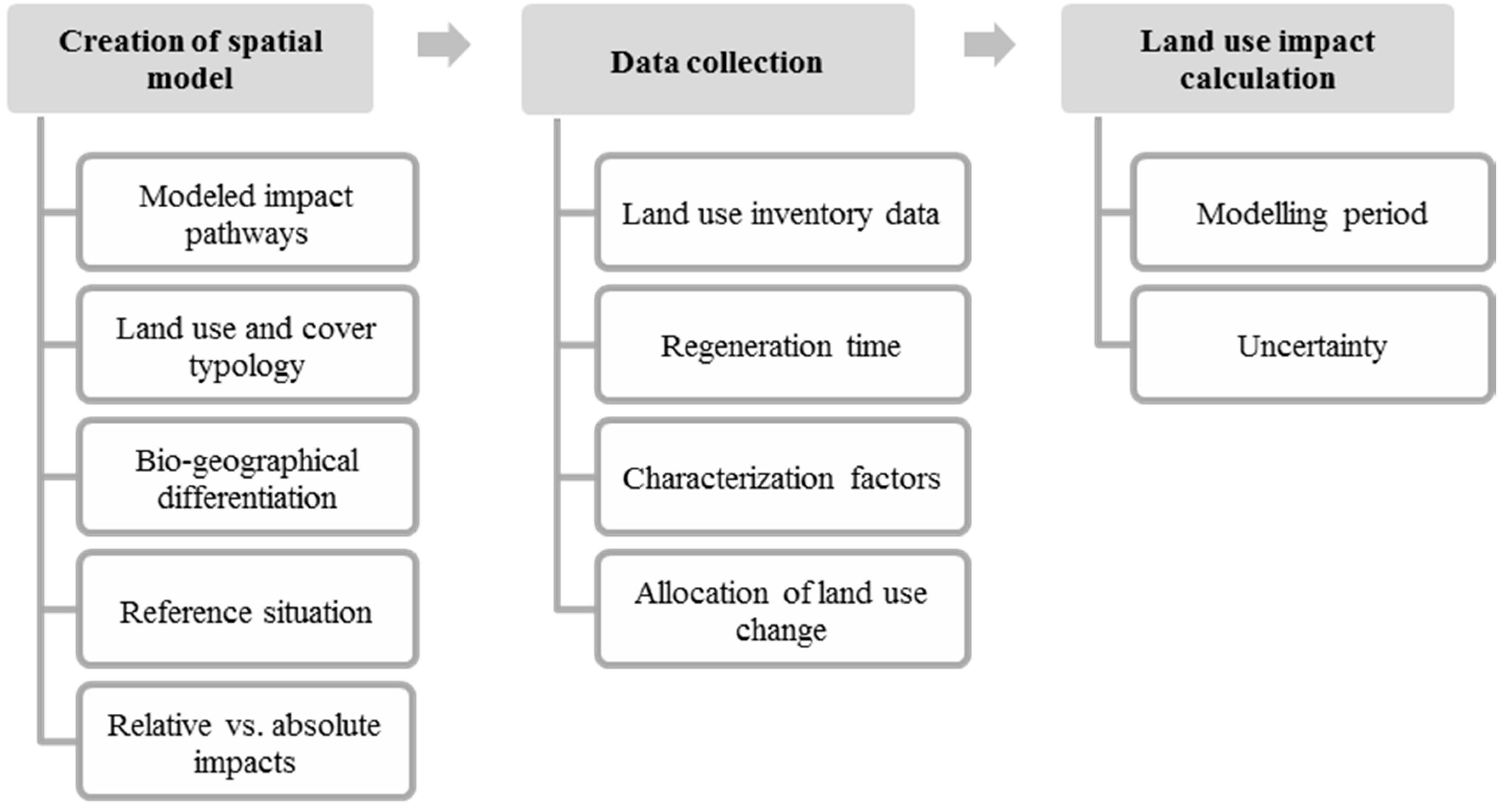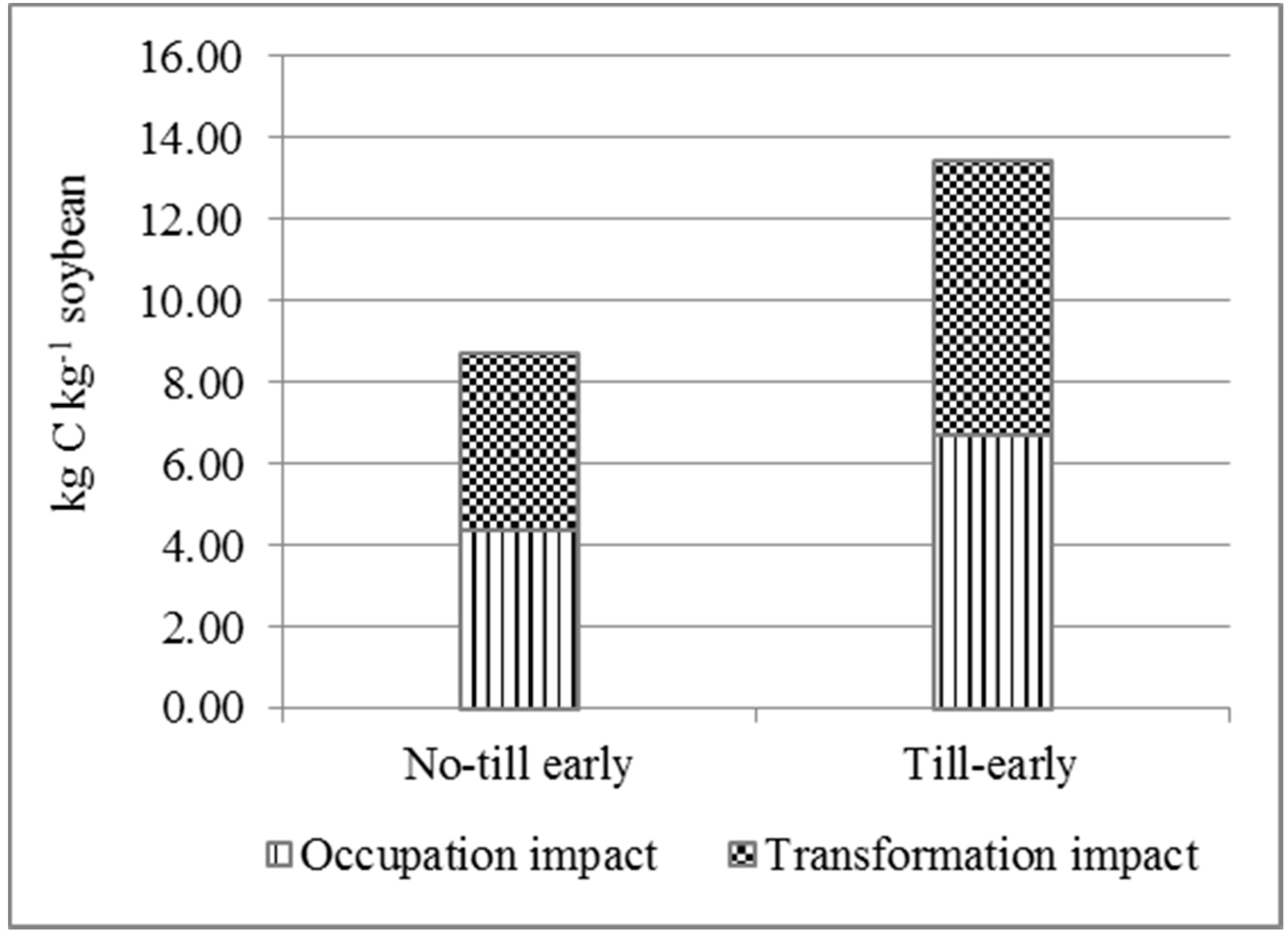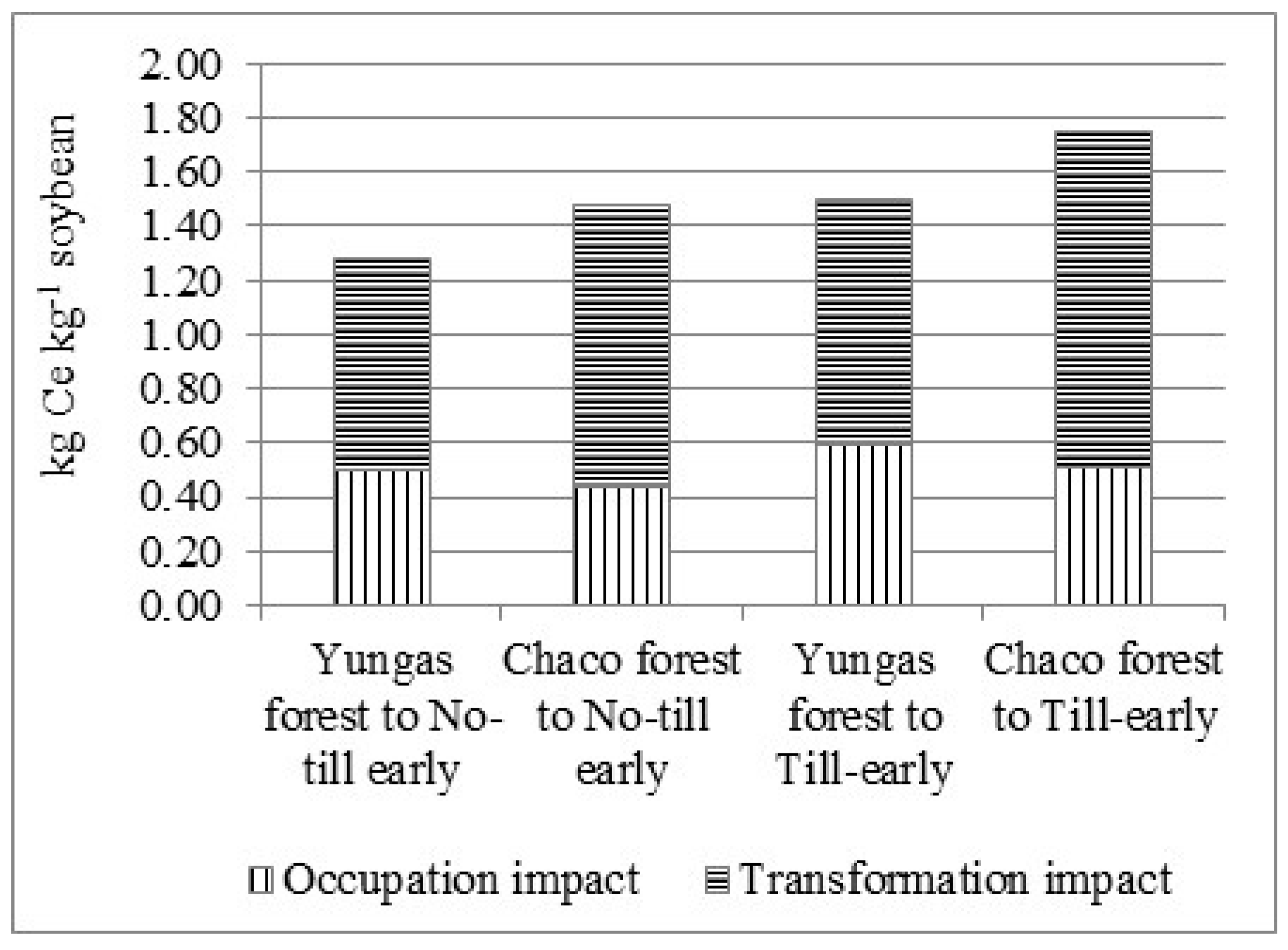1. Introduction
The growing interest in environmental impacts linked to the production and consumption of goods and services have fostered the development of methodologies that enable quantifying the said impacts and evaluating the environmental advantages of alternative products. In this sense, one of the strongest tools is the Life Cycle Assessment (LCA), endorsed by the International Organization for Standardization through the ISO 14040 [
1] e ISO 14044 [
2] norms.
Land use and the associated potential impacts have lately gained relevance in LCA studies of agricultural products. The term “land use” refers to a classification of human activities that occupy a land area, while the expression “land use impacts” denotes changes of anthropic origin produced in the land quality, such as decreases in biodiversity, increased soil compaction or loss of nutrients [
3], related to physical occupation and transformation of land areas. These cause modifications in the quality of ecosystems, meaning the capacity of bearing biodiversity and rendering services to society, such as the production of biomass and catching hydric resources [
4]. The land occupation implies impacts over flora, fauna, soil and soil surface during a period which human activity is maintained, while the process of transformation, commonly known as “land use change” (LUC), denotes changes in the flora, fauna, soil or soil surface from an original state to an altered state [
5].
Several authors have studied different indicators to evaluate land use impacts [
6,
7,
8,
9,
10,
11,
12,
13,
14,
15], considering aspects like the surface of occupied land, the influence over biodiversity, the life-support functions, soil productivity, and the capacity of ecosystems to dissipate exergy. However, it is not simple to apply these indicators in LCA studies of products, which is why the UNEP-SETAC Life Cycle Initiative has recently developed a methodological guide [
5] to evaluate occupation and transformation impacts of the soil over biodiversity and ecosystem services with life cycle thinking, applicable to any planet region.
Most available studies on land use impacts in the life-cycle of agricultural products are focused on evaluating changes in greenhouse gas emissions resulting from crop expansion towards other ecoregions [
16,
17]. Others include indicators related to the changes in the soil organic matter, the acidification and the eutrophication [
18], the soil erosion, the changes in soil structure and the loss in biodiversity [
19]. A few studies use the methodology proposed by the UNEP-SETAC [
5]. Among them are Milà i Canals
et al. [
20] and Antón
et al. [
21]. Milà i Canals
et al. [
20] study land use impacts over biodiversity and ecosystem functions of different crops used as raw material to manufacture margarine. Antón
et al. [
21] evaluate impacts of the biotic production, biodiversity and soil erosion of intensive (use of chemical fertilizers and pesticides) and extensive (includes organic manure application and the use of intermediate crops to catch excess nitrogen) crop production.
Nevertheless, the studies available do not contemplate possible modifications in impact results associated with the adoption of different tillage systems and conservationist practices.
One of the conservationist agricultural practices that has been adopted widely in recent years is that of no-tillage. This technology operates in the absence of any type of plowing and in the presence of a permanent soil covering with previous crop stubble. This practice allows production without damaging the soil, and very often improves its physical, chemical and biological conditions. At the moment, about 135 million hectares are produced around the world in no-tillage [
22] concentrated in a few countries, the United States, Brazil and Argentina being among them.
No-tillage enables simplifying crop handling and incrementing productivity levels per hectare of occupied land, motivating a large number of producers to expand the cultivated surface. To incorporate new agricultural land involves not only the use of land, degraded or in disuse, but also the advance toward preservation areas of natural ecosystems and the transformation of cattle breeding areas or areas of lower income yield capacity, thus awakening a growing concern in different sectors of society.
The aim of this study is to determine the potential impact on biotic production and climate regulation due to the use of land during the agricultural phase of soybean (
Glycine max) in Argentina, considering different practices in crop management. The impact caused by the occupation of land is calculated in the most common soybean cultivation conditions in the country: conventional tillage, no-tillage, rainfed cultivation and cultivation with supplementary irrigation. The impacts due to the transformation of land use from conservation areas to cultivated ones are also evaluated. The land use inventory methodology proposed by Koellner
et al. [
5] is considered. A regional approach is followed during the impact assessment phase, differentiating the intrinsic characteristics of the different ecoregions where the crop is cultivated in Argentina.
4. Discussion
From the analyses of methodologies adopted for estimating the CF of occupation and transformation impacts on BPP and CRP, it comes to light that there is a significant shortcoming in terms of availability of representative factors of biomes and ecoregions of Argentina, as well as regional agricultural practices. In the case of the methodology by Müller-Wenk and Brandão [
42], the
Cta and
df coefficients differentiate the impacts of land use between biomes, but do not distinguish between different tillage methods. These authors suppose that the changes in the soil C stock related to the different handling practices are insignificant when compared to the changes associated with the bio-geographical region characteristics and the type of land use. Therefore, the inclusion of soil management practices does not substantially change the impacts’ evaluation results. However, the results obtained when adopting the Brandão and Milà i Canals methodology [
40], whose characterization factors incorporate the different types of tillage, show that there is a significant variation (between 31% and 67%) in the occupation and transformation impacts over the BPP, whether a no-tillage or a conventional tillage is adopted. This difference is explained by the soil capacity to store carbon according to the type of tillage. This allows to suppose that, just as for the BPP, to incorporate modifications in the SOC occasioned by distinct agricultural handling practices might modify impact evaluation results over the CRP, with worse results for conventional tillage systems than for no-tillage.
As mentioned in the previous paragraph, the method proposed for Brandão and Milà i Canals [
40] presents factors that distinguish between no-tillage and conventional tillage. However, there are no factors for comparing systems in rainfed and irrigated conditions. Changes in land use impacts on ecosystem services evaluated between these systems are associated only with different crop yields. Nevertheless, this increment in yield promotes an increase in the amount of crop residues brought to the soil, which might result in a greater SOC stock [
57,
58,
59]. On the other hand, the greater moisture availability in the soil associated with irrigation implementation accelerates the microbial activity and the organic matter mineralization, and, as a consequence, increases the CO
2 flows toward the atmosphere. These additional flows of organic carbon entering the soil and the emissions of CO
2 entering the atmosphere might be neutralized or result in positive balances [
60,
61] or in negative balances [
62,
63] of SOC. However, they are not considered in the calculus procedures of characterization factors both for the BPP as for the CRP. Regarding the no-till late productive system, a similar analysis can be performed, considering that low crop yield compared to no-till early system implies a detriment in crop residues applied to the soil and, therefore, lower organic carbon stock. This consideration in the calculation of the characterization factors might enlarge the difference in the impact results between no-till early and no-till late systems. Referring to cropping sequences, the presence of a preceding crop increases SOC input from the soil [
64,
65]; however, this aspect is also not considered in the calculation of the FC. Furthermore, it is noted that factors in land use and soil management and crop recommended by Brandão and Mila i Canals [
40] to calculate the characterization factors for the BPP correspond to the values published in the IPCC Guidelines [
41].
It is worth pointing out that the land use and soil and crop handling coefficients used in the calculation of characterization factors for the BPP are taken from the Guidelines for National Greenhouse Gas Inventories [
41] following Brandão and Milà i Canals [
40] recommendations. These factors lead to significant failures for certain classes of use and handling; for example, for long-term cultivation in the tropical dry climatic region, the error reaches values of (±) 61% [
41], which would give imprecise results.
With respect to the transformation process, on evaluating the BPP, no distinction is observed in the magnitude of the impact when the soybean crop advances toward the Yungas forests or toward the Chaco forests. This is explained because the available values of
SOCpot correspond to level 2 of differentiation proposed by Koellner
et al. [
4]. For the CRP, the
CFtransf and consequently the magnitude of the impact on both ecoregions is strongly influenced by the C transfer rate per area unit associated with each of these levels. For the study case, the tropical grassland biome corresponds to the Chaco forest, which is assigned an average transfer rate of C of 58 t ha
−1, while for the Yungas forest the corresponding biome is the tropical forest. The adopted methodology allows disaggregating this type of biome in wet tropical forest and dry tropical forest sublevels, with very different C transfer rates: 231 t C ha
−1 for wet forests and 66.5 t C ha
−1 for dry forests. If instead of using the specific C transfer value for dry forests (as carried out in
Section 3.2.2) the mean value was used for both conditions of humidity—the same as for tropical grasslands—the results would change completely, reaching 2.85 kg Ce kg soybean
−1 year
−1 for no-till early and 3.36 kg Ce kg soybean
−1 year
−1 for till early system. That is, the most affected ecoregion through the expansion of soybean from the CRP point of view would clearly be the Yungas forests instead of the Chaco forests. Therefore, specific values have transfer rates of C for each biome and ecoregion would achieve greater objectivity in the results. By contrast, adopting global factors could lead to bad decisions as to the effects of production systems on ecosystem services of different ecoregions.
Another variable that significantly affects the results is the regeneration time. Brandão and Milà i Canals [
40] recommend adopting a total of 20 years for transformation toward crop lands, independently of the biome that may represent the reference situation. Meanwhile, Müller-Wenk and Brandão [
42] suggest more extensive and specific regeneration time and for each type of biome; for example, 62 years for tropical forests and 97 years for tropical grasslands. Specifically for Yungas forest, Grau
et al. [
56] determined that certain structural characteristics of mature forests, such as species diversity, richness of tree species, stem density and canopy height, are reached after 30–40 years of ecological succession over abandoned farmlands.
Figure 6 shows the influence of the regeneration time in the results of transformation impacts for no-tillage system, up to the point in which the impact estimated with the regeneration time recommended by Müller-Wenk and Brandão [
42] is similar to the impact associated with a conventional tillage system evaluated with the regeneration time suggested by Grau
et al. [
56].
Figure 6.
Impacts of land transformation of soybean crop in the Yungas forests on Biotic Production Potential, considering the no-till early and till early farming systems, for regeneration times suggested by different authors: (
A): [
40]; (
B): [
56]; and (
C): [
42].
Figure 6.
Impacts of land transformation of soybean crop in the Yungas forests on Biotic Production Potential, considering the no-till early and till early farming systems, for regeneration times suggested by different authors: (
A): [
40]; (
B): [
56]; and (
C): [
42].
5. Conclusions
Land use occupation and transformation impacts were evaluated over the Biotic Production Potential and Climate Regulation Potential, in the life cycle soybean production in Argentina. The methodology recently developed by the UNEP-SETAC [
5] was adopted and the differential characteristics of tillage and crop handling practices of major diffusion in the country were evaluated.
The results show that for all the systems studied, there exists an impact potential that negatively affects the ecosystem services of the region where the activity is developed, although with important differences among those related to soil carbon stock and grain yield reached. In effect, the impact magnitude is considerably reduced when implementing no-tillage instead of conventional tillage. This reduction is even greater when the system adopts supplementary irrigation.
As a consequence, it is recommended to continue expanding the soybean surface in no-tillage, thus replacing conventional tillage in the Argentinean Pampean Region, as a strategy to attenuate land use impacts. This would allow an impact reduction across the ecosystem services of up to 40% per hectare of soybean occupied land. It is necessary that the no-tillage expansion be complemented with an adequate crop sequences plan, since this system generates increments in environmental benefits of at least 50%. As to the irrigated system, it is recommended to carry out, prior to making decisions regarding its expansion, a total analysis that will take into account environmental benefits related to land use as well as water use impact potentials, energy balance and greenhouse gas emissions.
Although benefits in the balance of soil organic matter associated with conservationist practices are widely recognized in the technical and scientific world, they had never been previously considered for evaluating land use specific impact categories in LCA studies developed in Argentina. This work incorporates those aspects in the evaluation of land occupation and transformation impacts on Biotic Production Potential and Climate Regulation Potential of one of the country’s most relevant and controversial commodities, and confirms the benefits associated with no-tillage and cropping sequences.
As to the method adopted, the conclusion is that it is unable to show the expected differences between the distinct practices, given the weaknesses in data availability and in specific characterization factors. In some cases, the published factors present a high margin of error; in other cases, there are no particular values to determine soil and crop handling practices. Although the method applied to evaluate impacts over the Biotic Production Potential exhibits no-tillage advantages compared to conventional tillage, it does not count concrete characterization factors in differentiating rainfed or irrigation systems, delay or advances in tillage dates and cropping sequences. Furthermore, calculation procedures for the characterization factors used in evaluation impacts over Climate Regulation Potential does not allow any distinction among the different agricultural practices studied.
Therefore, it is absolutely necessary to develop characterization factors to include different management practices in methodologies for assessing impacts of land use. In order to do this it is suggested to consider SOC contributions in calculation procedures associated with a greater availability of crop residue, resulting in the adoption of no-tillage, cropping sequences and practices tending to increment harvest yield. In the same way, it is suggested to include in the determination of characterization factors the variations of the C mineralization ratio linked to irrigation water availability.
Another aspect worthy of considering in depth is how to determine the occupation and regeneration time for each type of land use and each ecoregion, in order to define common criteria in selecting and applying these study parameters for land occupation and transformation.











